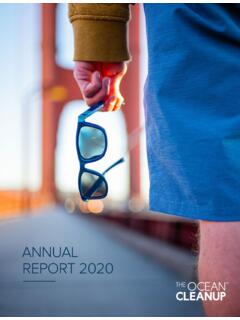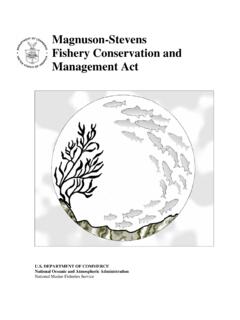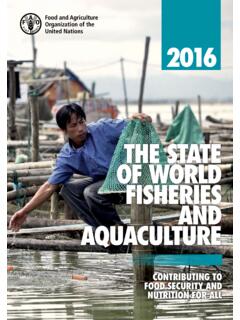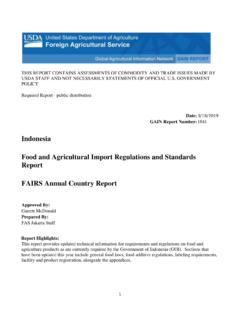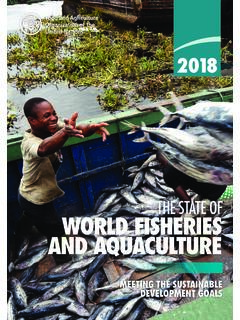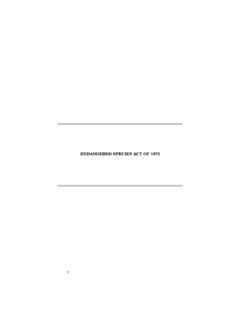Transcription of UK Sea Fisheries Statistics 2019 - GOV.UK
1 1 Contents Key Statistics ..4 About this publication ..5 Section 1: Fleet ..6 Fleet 7 Vessel Age of 12 Industry 13 Fishers on UK vessels .. 13 Fishers by UK nation .. 14 Section 2: 16 UK 16 Vessel 17 Vessel 18 Industry 19 Species group .. 20 Port .. 30 Landings abroad by the UK fleet .. 32 Landings into UK ports by foreign 34 Area of 35 Fishing gear .. 37 Landings by quota 38 Section 3: Effort .. 42 Over 10 metre 42 Sole Recovery 44 Western 45 Section 4: Trade .. 49 Imports and 49 55 55 Annex A: Fishing areas .. 56 Annex B: Additional 57 Annex C: Changes in 2019 .. 59 Annex D: Revisions policy .. 60 Annex E: Links and further information .. 61 Relevant links .. 61 2 Other MMO National Statistics publications.
2 61 MMO Official Statistics publications .. 61 Methodology .. 61 Sea Fisheries publications by other UK nations and international 62 Useful 62 Further Information .. 63 National Statistics 63 Pre-release access to Statistics .. 63 Contact .. 633 Key Statistics In 2019, there were 5,911 UK registered fishing vessels. This is a decrease of 125 compared to 2018. Almost 80 per cent of the UK fleet is made up of vessels of 10 metres and under in length. Vessels over 24 metres in length account for just 4 per cent of the total number but for three fifths of total capacity and a third of total power. There are around 12,000 fishers working on UK registered vessels. This has been stable for the past decade. Fleet In 2019, UK vessels landed 622 thousand tonnes of sea fish with a value of 987 million.
3 Compared to 2018, this is a reduction of 11 per cent and 2 per cent in quantity and value respectively. This is mainly driven by a reduction in the quota for key pelagic species mackerel between 2018 and 2019. In 2019, 34 per cent of all landings by UK vessels into UK ports were into Peterhead. Peterhead is consistently the UK port with the largest quantity and value of landings. Landings Fishing effort by the over 10m fleet decreased by only 3 per cent between 2018 and 2019, following the levelling off seen since 2011. Since 2003, fishing effort by the over 10m fleet has decreased by 35 per cent. Most of the reduction in effort is driven by a 36 per cent decline in effort (2004-2019) in the demersal trawl and seine segment. Effort The UK is a net importer of fish, with imports exceeding exports. The UK s trade gap in 2019 for sea fish is 270 thousand tonnes.
4 In 2019, the UK imported 721 thousand tonnes of sea fish, with a value of 3,457 million. It exported 452 thousand tonnes with a value of 2,004 million. Trade 4 About this publication This year there have been some substantial changes to the content included in this publication. We want this publication to better serve its audience by being more accessible and insightful. Feedback from users and from the Office for Statistics Regulation has driven these changes. We welcome feedback from you on the content of this release. Does this update better meet your needs? What more would you like to see? Please email the Statistics and Analysis Team at MMO with your thoughts. The aim of this publication is to provide a comprehensive picture of UK Sea Fisheries in 2019, recent trends and long-term historical context, back to 1938 in some instances.
5 The publication is a summary of: The UK fishing fleet Its activity at sea o Landings how much fish they catch and land o Effort how long they spend at sea Trade This report contains charts and commentary to describe UK sea Fisheries . View the accompanying tables for each section and underlying datasets here: The data and tables that feed into this release have remained consistent with previous years. However, the section and tables number have changed. See Annex C if you are looking to find a table you have used previously. 5 6 Section 1: Fleet View the tables accompanying this section here: Fleet characteristics Capacity and power As well as the total number of vessels, the fleet can also be assessed in terms of their capacity and power. Capacity is usually measured in gross tonnage (GT) which is a volumetric measure of a vessel capacity.
6 The power (kW) of a vessel refers to the vessel s engine power. The MMO holds data on the capacity and power of all individual UK vessels and these figures are aggregated to compare groups of interest. This allows for a more nuanced assessment of the fleet, as opposed to looking at the number of vessels alone. The number of UK fishing vessels has reduced by almost 50 per cent over the past three decades, from over 11 thousand vessels to below 6,000. The power (kW1) of the UK fleet has also decreased by 40 per cent over the past three decades2. Two key changes which have contributed to this are national and international policies introduced to ensure the future sustainability of fish stocks: 1. Greater controls on fishing opportunities, 2. Fleet capacity reductions through decommissioning exercises Compared to 2018, the number of UK vessels has fallen by 125, a decrease of 2 per cent and similar to the change between 2017 and of these were vessels under 10m in length.
7 1 Power of a fishing vessels engine. 2 See Table here: report-2019. 7 Figure : England has the highest number of vessels by UK country, while Scottish vessels have the highest capacity Although Scottish vessels account for 36 per cent of the total number of vessels, they have the highest share of capacity (57 per cent) and power (49 per cent). This is explained by the different composition of the fleets, particularly the length of vessels. 3 In this figure and throughout the publication, Islands refers to the Crown Dependencies of Isle of Man, Jersey and Guernsey. 8 Vessel length Figure : Three-quarters of Scottish vessels are under 10 metres long compared to 82 per cent of English vessels The smaller number yet higher capacity of Scottish vessels (Figure ) can be explained by Scotland having proportionally more large and powerful vessels.
8 Fish stock A fish stock refers to a fish population that is isolated from other stocks of the same species. For example, around the UK there are several cod stocks including Cod 7d in the Channel and North Sea Cod. Many fish stocks are managed by quotas limits set on the tonnage that can be caught. Currently the UK has quota for around 100 different fish stocks. Owing to the diverse nature of the fishing industry, it is difficult to provide a simple explanation of the variation seen across the fleet. The main influencer is the different fish stocks that the fleets target. Key elements of the Scottish fleet target several Fisheries that are high volume but lower priced, such as herring and mackerel caught in the North Sea and West of Scotland waters5. To target these stocks, the Scottish fleet has moved towards having higher capacity vessels which cover large sea areas and can catch several hundred tonnes of fish per trip.
9 4 In this figure and throughout the publication, Islands refers to the Crown Dependencies of Isle of Man, Balliwick of Jersey and Balliwick of Guernsey. The category Other are vessels which are registered but not administered by a port; typically, new vessels and vessels changing administrations. 5 See Annex A for a map of the fishing areas around the UK. 9 Compared with this, the English fleet is involved in several key Fisheries that are typically lower volume but higher priced, such as the Channel Fisheries for sole and plaice. In addition, a greater proportion of the Fisheries pursued by the English fleet cover inshore areas. Together these factors have allowed the English fleet to develop with a greater proportion of smaller vessels that are able to be economically viable through catching smaller quantities of more valuable fish.
10 Changes in fishing opportunities over time have been key drivers for the development of the fleet. Figure : The number of vessels per length group falls as capacity increases Almost 80 per cent of the UK fleet is made up of vessels 10 metres and under in length. These vessels account for 9 per cent of the fleet s tonnage and 35 per cent of the fleet s power. Vessels over 24 metres in length account for just 4 per cent of the total number but 63 per cent of the fleet s capacity and 35 per cent of the fleet s power. 10 By Fisheries administration6, Scotland and Northern Ireland have a higher proportion of large vessels than England and Wales. For example, 16 per cent of the Scottish fleet exceed 15 metres in length compared with 5 per cent in England. The capacity of the 335 Scottish vessels over 15 metres in length (6 per cent of all UK vessels) is almost equal to the capacity of the rest of the UK fleet combined.











